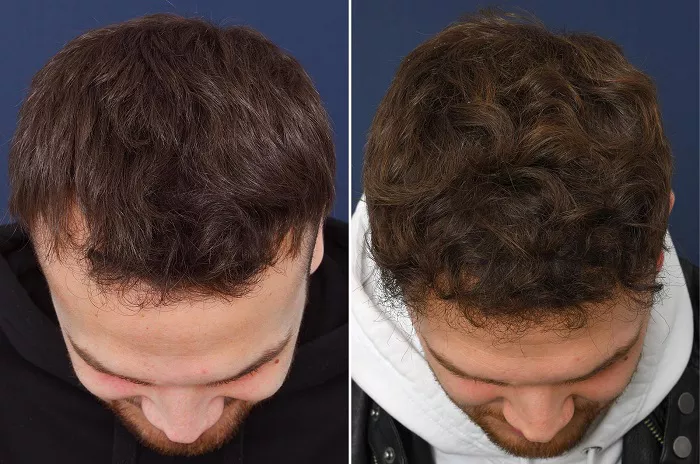Hair transplant surgery is a delicate procedure that involves the transplantation of hair follicles from one part of the scalp to another. After the surgery, patients may experience facial swelling, which can be a common side effect. In this article, we will explore the answer to the question of how long facial swelling lasts after a hair transplant.
The Causes of Facial Swelling After Hair Transplant
Facial swelling after a hair transplant can occur for several reasons:
Local Anesthesia
During the hair transplant surgery, the surgeon may use local anesthesia to numb the scalp. Local anesthesia can cause swelling and bruising, which can lead to facial swelling after the surgery.
Trauma to the Scalp
Hair transplant surgery involves the transplantation of hair follicles from one part of the scalp to another. This process can cause trauma to the scalp, which can result in swelling. The body’s natural healing process can also cause swelling as it works to repair the damaged tissue.
Inflammation
Inflammation is a natural response of the body’s immune system to injury or trauma. After a hair transplant, the body may respond with inflammation, which can result in swelling.
Fluid Retention
After a hair transplant, the body may retain fluids as it works to heal the damaged tissue. This can result in swelling, particularly in the face and scalp.
Allergic Reactions
In rare cases, patients may experience an allergic reaction to the anesthesia or medications used during the hair transplant surgery. This can cause facial swelling, as well as other symptoms such as itching, hives, and difficulty breathing.
In conclusion, facial swelling after a hair transplant can occur for several reasons, including local anesthesia, trauma to the scalp, inflammation, fluid retention, and allergic reactions. While facial swelling is a common side effect after a hair transplant, it is important to follow the post-operative care instructions provided by your surgeon to minimize swelling and promote proper healing. If you experience severe or prolonged facial swelling after a hair transplant, it is important to contact your surgeon to ensure proper treatment and care.
How Long Does Facial Swelling Last After Hair Transplant?
The duration of facial swelling after a hair transplant can vary depending on several factors, including the extent of the surgery, the patient’s overall health, and the individual’s healing process. In general, most patients experience facial swelling for the first few days after the surgery, which gradually subsides over the next few days.
The first 24-48 hours after the surgery are typically the most critical, as this is when the swelling is at its peak. During this time, it is important to follow the post-operative care instructions provided by your surgeon to minimize the swelling and promote proper healing. This may include applying cold compresses to the affected area, avoiding strenuous activity, and taking any prescribed medications to manage pain and swelling.
After the first few days, most patients will experience a gradual reduction in facial swelling. However, it is important to note that individual healing times can vary, and some patients may experience swelling for a longer period of time. In general, most patients can expect to see a significant reduction in facial swelling within 7-10 days after the surgery.
Tips for Minimizing Facial Swelling After Hair Transplant
Follow the Post-Operative Care Instructions
Following the post-operative care instructions provided by your surgeon is crucial in minimizing facial swelling after a hair transplant. These instructions may include applying cold compresses to the affected area, avoiding strenuous activity, and taking any prescribed medications to manage pain and swelling. It is important to follow these instructions closely to promote proper healing and minimize swelling.
Apply Cold Compresses
Applying cold compresses to the affected area can help to reduce swelling after a hair transplant. Cold compresses can help to constrict blood vessels, which can reduce inflammation and swelling. Patients should apply cold compresses to the affected area for 20-30 minutes at a time, several times a day, for the first few days after the surgery.
Elevate Your Head
Elevating your head while sleeping can help to promote proper blood flow and reduce swelling after a hair transplant. Patients should use pillows to prop up their head and keep it elevated while sleeping for the first few days after the surgery.
Avoid Strenuous Activity
Strenuous activity can increase blood flow and cause swelling after a hair transplant. Patients should avoid any activities that can increase blood pressure or cause sweating for the first few days after the surgery. This may include exercise, heavy lifting, and bending over.
Stay Hydrated
Staying hydrated can help to flush out excess fluids and reduce swelling after a hair transplant. Patients should drink plenty of water and avoid alcohol and caffeine, which can dehydrate the body and increase swelling.
Avoid Smoking
Smoking can interfere with the healing process and increase the risk of complications after a hair transplant. Patients should avoid smoking for at least two weeks after the surgery to minimize swelling and promote proper healing.
In conclusion, facial swelling is a common side effect after a hair transplant surgery. By following the post-operative care instructions provided by your surgeon and taking steps to minimize swelling, patients can promote proper healing and achieve optimal results from their hair transplant surgery.
Conclusion
In conclusion, facial swelling after a hair transplant is a common side effect that typically lasts for the first few days after the surgery. The duration of facial swelling can vary depending on individual healing times, but most patients can expect to see a significant reduction in swelling within 7-10 days after the surgery. By following the post-operative care instructions provided by your surgeon and taking steps to minimize swelling, patients can promote proper healing and achieve optimal results from their hair transplant surgery.
Related Topics:

